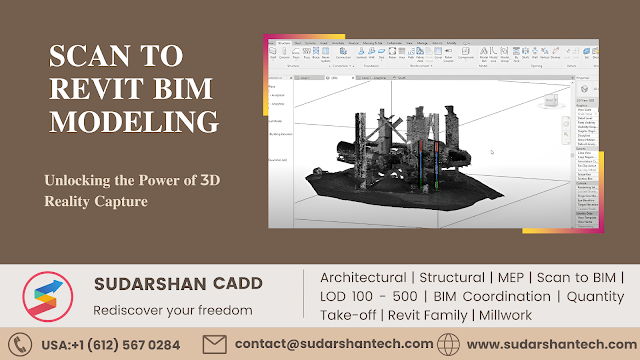𝐒𝐂𝐀𝐍 𝐓𝐎 𝐑𝐄𝐕𝐈𝐓 𝐁𝐈𝐌 𝐌𝐎𝐃𝐄𝐋𝐈𝐍𝐆: 𝐔𝐧𝐥𝐨𝐜𝐤𝐢𝐧𝐠 𝐭𝐡𝐞 𝐏𝐨𝐰𝐞𝐫 𝐨𝐟 3𝐃 𝐑𝐞𝐚𝐥𝐢𝐭𝐲 𝐂𝐚𝐩𝐭𝐮𝐫𝐞
Introduction
Scan to
Revit BIM modeling is revolutionizing the architectural and construction
industries by combining cutting-edge technology with Building Information
Modeling (BIM). This innovative process allows for the creation of highly
accurate and detailed 3D models from laser scans or point cloud data, providing
a comprehensive digital representation of existing structures. In this blog
post, we will explore the benefits and applications of Scan to Revit BIM
modeling and how it is transforming the way professionals approach design,
renovation, and facility management. Rediscover your freedom in engineering
services with Scan to Revit BIM modeling and unlock new possibilities for
innovation and efficiency.
The Advantages of Scan to Revit BIM
Modeling
- Accurate Digital Representation: Scan to Revit BIM modeling enables the
creation of precise and detailed 3D models by capturing real-world data.
This accurate digital representation enhances the visualization and
understanding of existing structures, allowing architects and engineers to
make informed design decisions and rediscover their freedom to create.
- Efficient Renovation and Retrofitting: With the help of Scan to
Revit BIM modeling, professionals can easily assess the feasibility of
renovation or retrofitting projects. The as-built 3D models provide
valuable insights into the existing conditions, ensuring compatibility and
reducing potential clashes during the design phase, giving you the freedom
to execute projects seamlessly.
- Streamlined Facility Management: Scan to Revit BIM modeling plays a
crucial role in facility management. By integrating 3D reality capture technology
with BIM, facility managers can access a comprehensive database of the
building's components, maintenance history, and spatial information. This
streamlines maintenance and operations, allowing you the freedom to
optimize facility management services.
- Enhanced Collaboration and Communication: Scan to Revit BIM models
serve as a common platform for collaboration among project stakeholders.
The highly detailed and accurate models facilitate effective
communication, reducing errors and rework while promoting seamless
coordination among architects, engineers, contractors, and owners. This
enhances your freedom to collaborate and deliver successful projects.
- Data-Driven Decision Making: The captured data in Scan to Revit BIM models can be utilized for data analysis and simulations, enabling data-driven decision making. Professionals can evaluate energy efficiency, perform clash detection, and simulate different scenarios, optimizing design choices and improving project outcomes. This empowers you with the freedom to make informed decisions based on accurate data.
Applications of Scan to Revit BIM Modeling
- Architectural Design: Scan to Revit BIM modeling aids architects in designing additions or modifications to existing structures with precision and accuracy. The as-built 3D models provide a solid foundation for creating innovative and compatible designs, allowing you the freedom to unleash your creativity.
- Construction and Renovation: Construction and renovation projects benefit from Scan to Revit BIM modeling by reducing risks and improving project outcomes. The as-built 3D models enable better planning, cost estimation, and coordination, resulting in efficient construction processes. This gives you the freedom to execute projects smoothly and deliver high-quality results.
- Historical Preservation: Scan to Revit BIM modeling proves invaluable in the preservation and restoration of historical structures. The technology captures intricate details, enabling preservationists to accurately document and recreate historical elements. This helps in rediscovering the freedom to preserve our heritage with precision and care.
- Facility Management and Maintenance: Facility managers utilize Scan to Revit BIM models to optimize maintenance activities, plan space utilization, and track asset performance. The digital database provides comprehensive information for efficient facility management, allowing you the freedom to enhance maintenance services and ensure smooth operations.
Conclusion
Scan to Revit BIM modeling revolutionizes the way professionals approach design, renovation, and facility management in engineering services. By harnessing the power of 3D reality capture, architects, engineers, and facility managers can rediscover their freedom to innovate, collaborate, and optimize services. Embrace the potential of Scan to Revit BIM modeling and unlock new opportunities for creativity, efficiency, and excellence in the field of engineering.
Contact us now: +91 93133 80923
𝑭𝒐𝒍𝒍𝒐𝒘 𝒖𝒔 𝒉𝒆𝒓𝒆 𝒂𝒏𝒅 𝒗𝒊𝒔𝒊𝒕 𝒐𝒖𝒓 𝒘𝒆𝒃𝒔𝒊𝒕𝒆 𝒘𝒘𝒘.𝒔𝒖𝒅𝒂𝒓𝒔𝒉𝒂𝒏𝒕𝒆𝒄𝒉.𝒄𝒐𝒎



.png)
Comments
Post a Comment